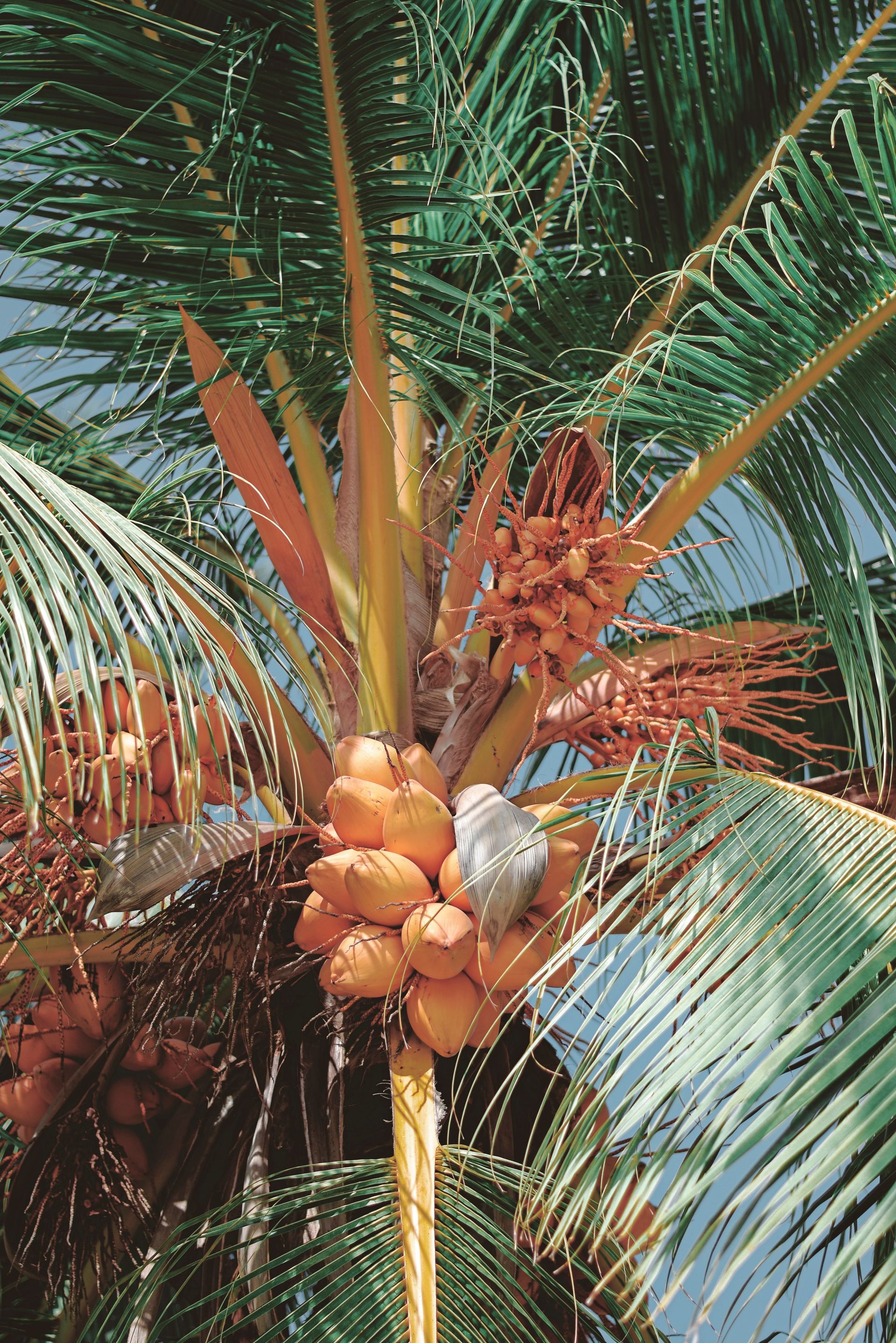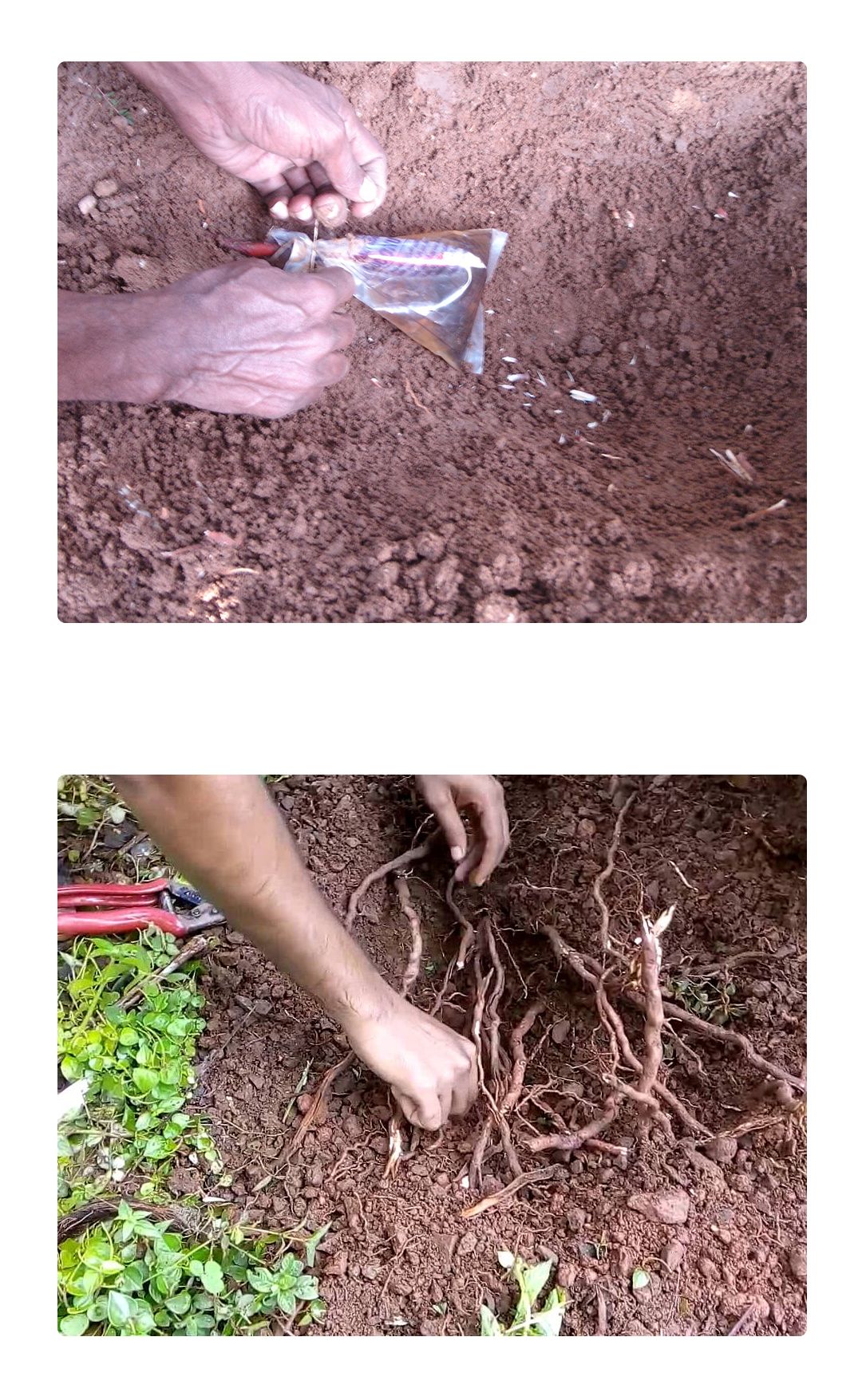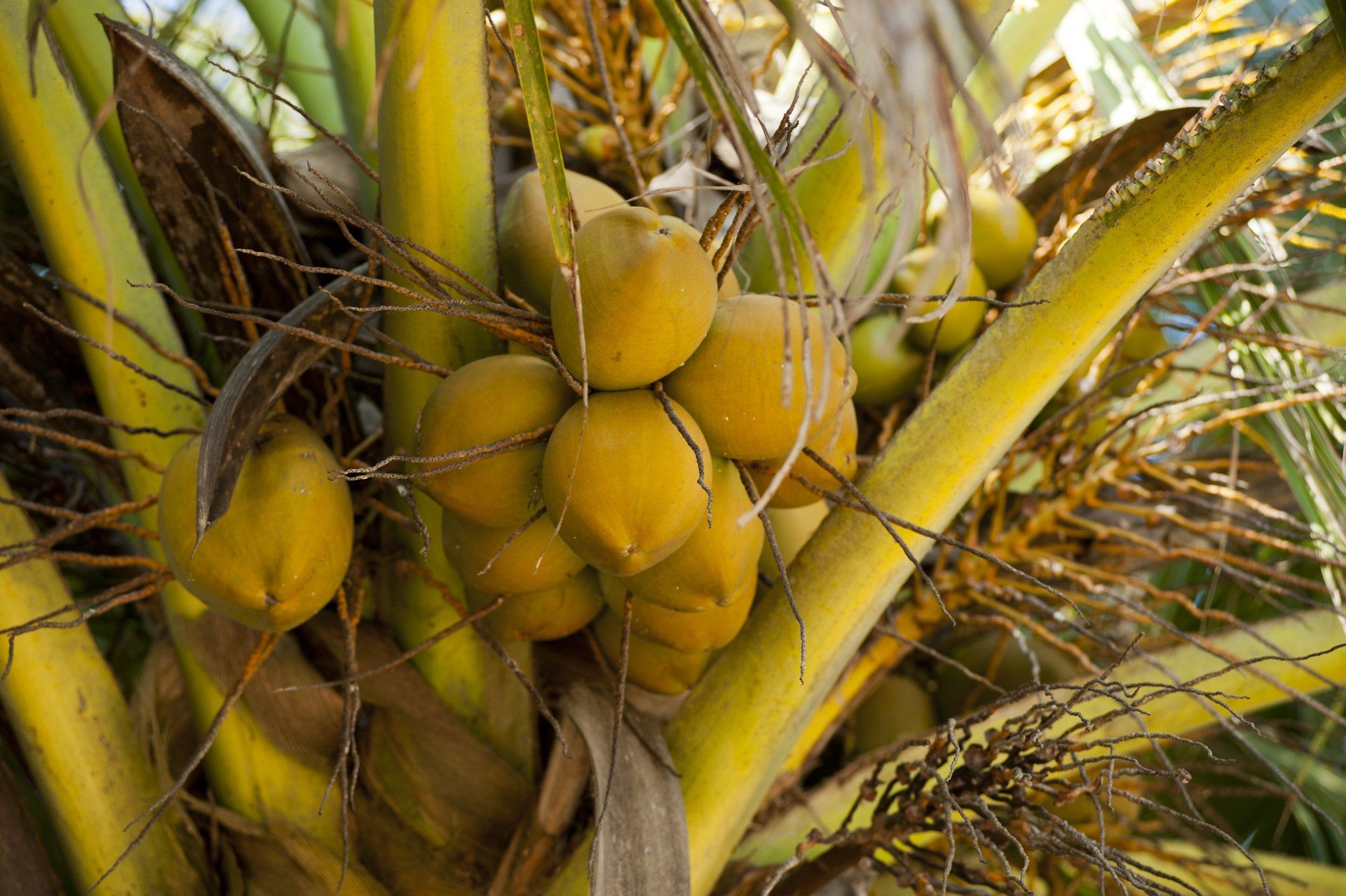Coconut Cultivation
The coconut palm is an essential tropical crop that grows best in warm, humid climates. It thrives well under an evenly distributed annual rainfall ranging from 1000 mm to 3000 mm. However, a well-distributed rainfall of about 2000 mm is ideal for proper growth and higher yield. Coconut trees do not tolerate extremes of tempera- ture, long dry spells, and severe cold conditions.
Suitable Soil Conditions
The coconut palm can tolerate a wide range of soil conditions, but it does show certain growth
preferences. A variety of factors such as drainage, soil depth, soil fertility, and layout of the land
greatly influence the growth of the coconut palm. The major soil types that support coconut farming in
India are laterite, alluvial, red sandy loam, coastal sandy, and reclaimed soils, with a pH ranging from
5.2 to 8.
Intercropping for sustainable ecosystem
Coconut seedlings are typically planted at a distance of 7 to 10 feet between each palm. Adopting a system of intercropping can maximize the utilization of soil and sunlight in the coconut farm. Crop varieties like pineapple, banana, elephant foot yam, groundnut, chilies, sweet potato, and tapioca,
which live for 8 to 10 years, are good options. They help prevent soil erosion during seasonal monsoon
rains and also add nutritional value to the soil, along with providing growers with additional income
opportunities.
Other mixed-cropping options include perennials like cocoa, pepper, cinnamon, clove, and nutmeg.
Mixed farming by raising fodder grasses such as hybrid napier or guinea grass, along with leguminous fodder crops, in coconut farms is a sustainable and profitable way to support the rearing of milch
animals.
Cultural practices to maximize coconut yield potential
A number of factors affect the yield potential of the coconut palm. Implementing certain techniques
and agricultural practices can help increase the yield potential significantly. The following are some of
the methods that help:
01
Coconut seedling selection and transplantation
∙Good quality seedlings should be selected and planted.
∙Apply a mixture of sand, salt, and ash in the pit before transplanting. Sand improves drainage, salt improves soil conditions and loosens the laterites, and ash enriches soil potassium levels.
02
Setting up the irrigation and draining system
∙Coconut trees are planted on bunds raised at 2 m breadth and 1 m height to prevent water logging around the base.
∙Pineapple is generally planted hilly slopes and erosion-prone zones. Apart from controlling soil erosion, it gives good yield with the available water.
∙Drought conditions can be managed by plowing into the soil rice husks, saw dust, old coconut fronds, or decomposed paddy straw to the root zone to reduce the water evaporation rate.
03
Improving coconut palm pollination and fruit set
∙Fixing bee hives in coconut farms improves the pollination rate.
∙Creating smoke with Ayurveda ingredients helps to control pests and improve the seed set by
hormonal up regulation.
04
Nutrient management
To maintain the soil fertility and improve palm productivity, green manures and multiple crop
seeds are sown around the tree basin and incorporated into the soil at its flowering stage, i.e. around 45 days after sowing, when the nitrogen fixation is at its maximum. It takes nearly 10 to
15 days for decomposition. This practice improves the physical and chemical (ph, Cation exchange capacity) properties of the soil.
Coconut varieties and their characteristics
The coconut plant may be broadly classified as tall and dwarf types. Hybrid varieties are also
cultivated as they give good yield under the right conditions. Understanding the standard
characteristics can help in coconut variety selection.
| Trait | Tall | Dwarf | Intermediate |
|---|---|---|---|
| Plant height | Tall (20 - 30m) | Short (10 - 15m) | Varies from short to tall |
| Life span | 60 – 100 years | 40 – 50 years | 40 – 60 years |
| Mode of pollination | Highly cross | Highly self | Highly self |
| Bearing nature | Continuous | Seasonal | Seasonal to continuous |
| Average nuts / year | 40 – 60 | 80 – 100 | 50 – 100 |
| Copra amount & quality | 200g/nut, good | 80 – 100g/nut, inferior | 100 – 150g, inferior |
| Leaf & bunch attachment | Strong | Fragile | Usually fragile |
| Pigmentation of nuts | Mixture of green, brown, and yellow | Pure green, brown, yellow, or red | Green or red |
Valarchi is a naturally derived organic fertilizer that has proven results in improving the growth of the coconut palm and in generating high yield. Its application comes in two variants—as a coconut soil fortifier and coconut root feeder.
1. Valarchi for coconut soil fortification
The Valarchi organic soil fortifier is formulated to enrich a coconut tree by releasing the nutrients steadily and slowly when applied to the soil at different stages of the tree growth. This acts not only as nutrient source but also helps immensely in plant nutrient uptake, along with enhancing the inherent capacity of a tree to withstand soil-borne diseases since it contains many plant-derived active
ingredients for activation of specific defense mechanisms for betterment of soil and plant health. Over a period of time, these parameters provide a long-lasting impact on the sequestration capacity of the tree, thus enabling self-nurturing or self-healing abilities. Valarchi also substantially helps in the “self-repairing” function of soil by providing a viable ecosystem for microorganisms, which acts as a
suitable buffer for exchange of necessary nutrition.
Valarchi coconut soil fortifier – Dosing instructions
∙5 to 12 months old palm – 1/2 kg per tree, 1 application
∙1 to 2 years old palm – 1 kg per tree, 2 applications
∙2 to 4 & above 5 years old palm – 1 kg per tree, 3 applications
∙Diseased and nutrient deficient tree – 2 kg per tree
Application procedure
Soil application – At 1.8 meter (or) 3 – 4 feet away from the base of the palm, incorporate at 10 cm
depth followed by immediate irrigation.
2. Valarchi Coconut root feeder
Valarchi coconut root feeder
The Valarchi coconut root feeder is a concentrated, organic tonic that is designed in such a way that it
is enriched with micronutrients, vitamins, and growth regulators in the right proportions, thus ensuring
the supply of all the essential nutrients besides providing natural protection to the trees against various
pests and other environmental stresses.
Benefits of Valarchi Coconut Root Feeder
∙Improves chlorophyll content and photosynthetic ability of leaves
∙Production of more healthy and green fronds
∙Reduces shedding of fertilized female flowers and buttons
∙Controls cracking of nuts with increase in kernel thickness
∙Increases longevity and vigor of palm
∙Increases number and size of nuts
∙Imparts resistance to drought, pests, and diseases
Dosage:
Dilute the concentrated tonic at a ratio of 1:4 with water and feed 200 ml per palm, twice a year,
at 6-month intervals (recommended especially for yielding palms).
Application procedure:
For coconut root feeding, select a pencil-thick feeding live root with white, light yellow, or pink color
at a distance of 2 to 3 feet away from the base of the palm. Make a slanting cut at the tip of the root
and insert it into the polythene sachet containing diluted Valarchi coconut root feeder and tie with
thread (avoid root feeding during rainy days).
Valarchi – Coconut fertilizer chart (for a palm per year)
| Interval | 1st month | 4th Month | 7th Month | 10th Month | 12th Month |
|---|---|---|---|---|---|
| Product | Valarchi Coconut Soil | Valarchi Coconut Soil | Valarchi Coconut Root | Valarchi Coconut Soil | Valarchi Coconut Root |
| Dosage | Fortifier – 1 kg | Fortifier – 1 kg | Feeder – 200 ml | Fortifier – 1 kg | Feeder – 200 ml |
Organic inputs for pests and disease in coconut trees
Tricit is a multipurpose pest management alternative to synthetic insecticides. It is non-hazardous and eco-friendly, with a formulation that is effective against a variety of pests and infections affecting coconut trees. Here are a few examples of the application of Tricit:
Coconut harvesting
In general, the nuts are harvested once in 3 to 4 months. However, in a well-maintained coconut farm, bunches are harvested once in two months. The coconuts normally take 10 to 12 months to mature from flowering stage.
Interested in our services? We’re here to help!
We want to know your needs exactly so that we can provide the perfect solution. Let us know what you want and we’ll do our best to help.



